The lowly dongle matures and evolves into a premium portable DAC/amp.
What differentiates a portable DAC/amp from a dongle? An internal battery? Output power? Features? Size?
Typically, a dongle is characterized by its small size, a lack of internal battery, and somewhat limited output power. On the other hand, a portable DAC/amp is usually far larger, offering more features and outputs and containing a battery to allow for higher output power and less source device drain.
- Legible OLED screen
- Volume/option knob provides a great tactile interface
- High-quality construction
- Internal battery blurs the distinction between a dongle and portable DAC/amp
- Tons of features and menu options
- Clean, uncolored sound
- Silent background
- Sufficient power to drive most IEMs and headphones
- No play/pause buttons or play controls beyond volume
- Not Apple friendly. No included Lightning to USB-C cable or adapter. The Eddict Player app is not compatible with the UA5 on iOS.
Today, we’ll explore another outlier, the UA5, Shanling’s TOTL dongle – or is it a portable DAC/amp? The US5 features such unusual features as an internal hybrid battery, OLED display, SPDIF output, balanced circuitry, and a rotary wheel controller.
Somehow all this is shoehorned into a tiny package, looking far more like a standard dongle than the VE Megatron.
I (perhaps arbitrarily) decided that the Megatron must be a dongle because it doesn’t have an internal battery. So, it follows that I have to rule that the UA5 is technically a portable DAC/amp. Although Shanling further muddies the water by allowing the UA5 to bypass its internal battery and run off USB power like a standard DAC/amp.
However, unlike the budget Megatron, the UA 5 is nearly five times more expensive and features a design and construction befitting a higher-end product.
The Megatron is the antithesis of the UA5.
Dongles have become increasingly popular – especially since the death of the 3.5mm socket – due to their promises of providing higher-quality audio and more power to better drive inefficient headphones. It now seems that every portable audio company has a variety of models, all promising to best the ubiquitous 3.5mm Apple dongle.
Unquestionably, the UA5 differentiates itself from the competition with its range of unusual features and options. But the question remains, does this feature set justify paying a premium price?
Let’s find out.
Company Overview
Founded in 1988, Shanling’s main offices are located in Shenzhen, China and the production factory is in Dongguang, China. They produce digital music players, portable amplifiers, headphones, SACD/CD players, and a variety of other audio products.
Shanling has obtained a series of patented technology qualifications, including SONY LDAC, Bluetooth BQB, Japanese Audio Association Hi-Res, Microsoft’s HDCD, Dolby Laboratories’ Dolby Digital, DTS and DVD, SACD, and CD patent licenses.
From the Shanling website,“…for over 30 years, Shanling’s employees kept integrity, innovation, team spirit and hard work in mind. There is no doubt that our employees are our treasure and that without them, we would never get to the Shanling of today. We believe customer’s satisfaction and quality of products are the highest priorities…”.
Technical Specifications
- Form: Portable DAC/amp.
- DAC: Dual ESS ES9038Q2M, 32 bit / 768 kHz and DSD152, 7 user selectable digital filters
- Amp: Dual Ricore RE6863 Opamps
- Removable Cable: USB-c
- Outputs: 3.5mm SE, 4.4mm balanced
- Power: 3.5mm: 1V @32 Ohms (137mW), 4.4mm: 6 Volts @ 32 Ohms (211mW)
- Frequency Response: 3.5mm: 20Hz to 50 kHz, 4.4mm: 20Hz to 50kHz (-0.5DB)
- THD+N: 3.5mm: 0005% @32 Ohms A-weighted, 4.4mm: 005% @ 32 Ohms A-weighted @ 1V
- Dynamic Range: 3.5mm: 122DB @32 Ohms, 4.4mm: 120dB @ 32 ohms
- Channel Separation: 3.5mm: 77dB @ 32 Ohms, 4.4mm: 110dB @ 32 Ohms
- SN ratio: 3.5mm: 121dB @32 Ohms A-weighted, 4.4mm: 116dB @32 Ohms A-weighted
- Output Impedance: 3.5mm: 8 Ohms, 4.4mm: 6 Ohms
- Digital Output: 3.5mm SPDIF Coaxial, 24-bit/192kHz
- Battery: 220mAh, Hybrid power mode
- Battery Life (hrs): 3.5mm: 6 hours / 4.4mm: 3 hours
- Weight (g): 29g
- Dimensions: 68(l)x27(w)x13(t)mm approximately
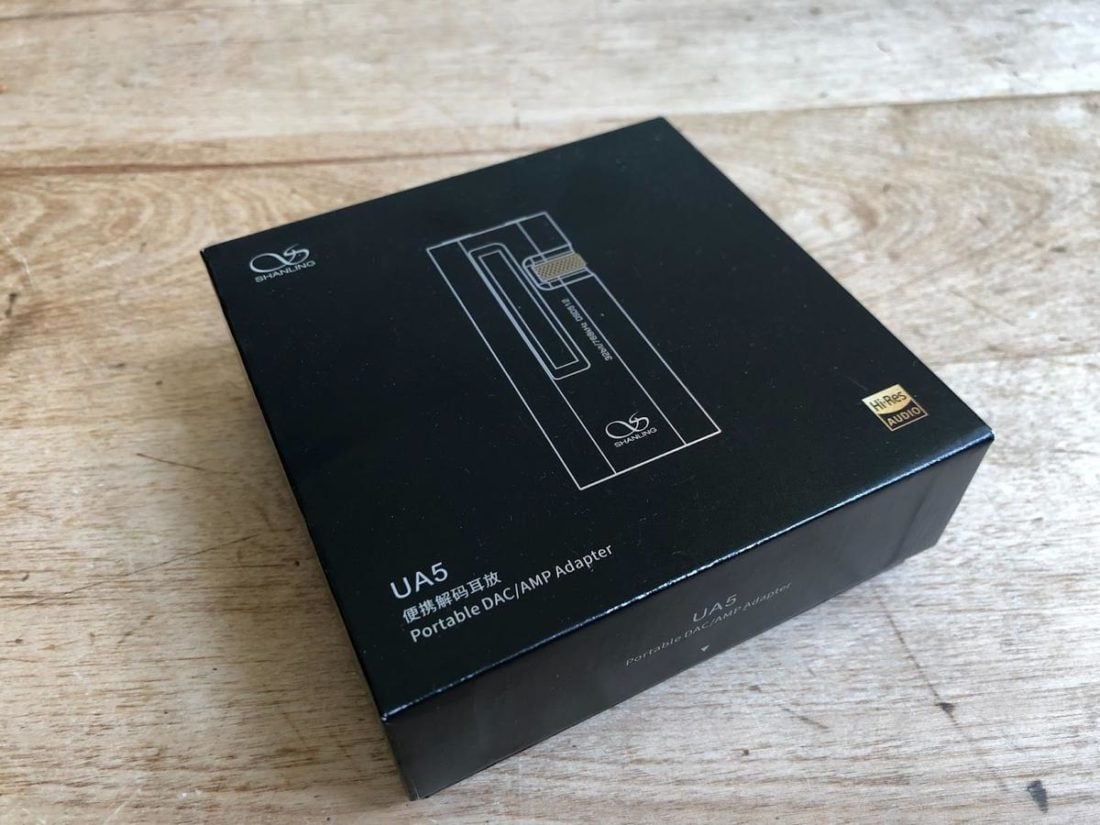
Packaging
The UA5 comes in a suitable black cardboard box with a silver line drawing of the device on the top and specs on the bottom. The UA5 nestles in a foam cut-out sheet alongside a USB-c to USB-a adapter. Underneath are the accessories, including a short OTG USB-c to USB-c cable, guide, warranty card, and Hi-Res Audio decals.

In the box
- UA5 portable DAC/amp
- USB-c to USB-c cable (110mm)
- USB-c to USB-a adapter
- User guide
- Warranty card
- Hi-Res Audio decals
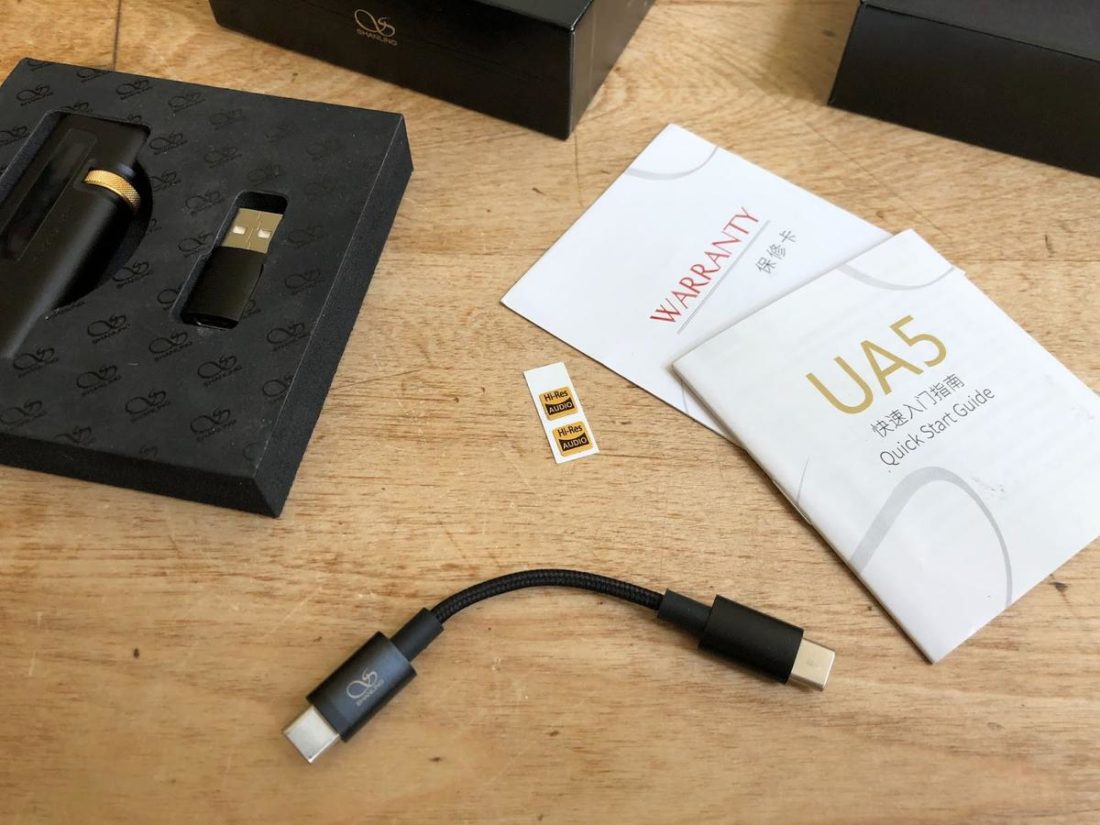
Cable
The included 11cm, black, nylon-sheathed, USB-c OTG cable is intended to tender the UA5 to an Android device, or to a computer using the USB-c to USB-a adapter. The cable can also charge the device and appears plain but well made.
The good news is that, unlike many other dongles, the UA5 doesn’t seem too picky with cables, and every one of the Lighting to USB-c cables I have on hand worked fine (JCally, Meenova, xDuoo, FiiO LT-LT1, and the ddHiFi TC28i adapter). Something I can’t say for the VE Megatron.
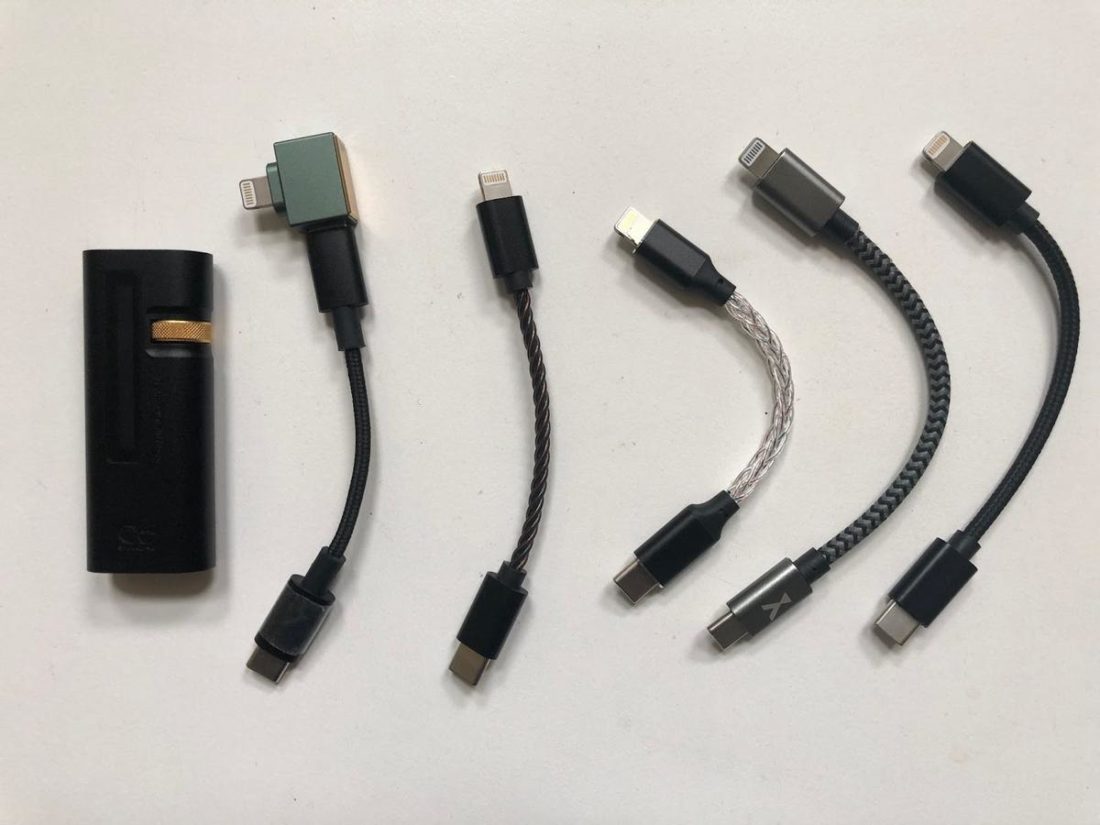
Design
The UA5 is slightly larger than many dongles but is far smaller than most portable DAC/amps. The popular Hidizs S9Pro dongle is 3-8mm shorter in all dimensions and about 1/3 the weight of the UA5.
But this doesn’t mean that the UA5 is overly large, as it’s only about the size and shape of a BIC lighter in your hand.
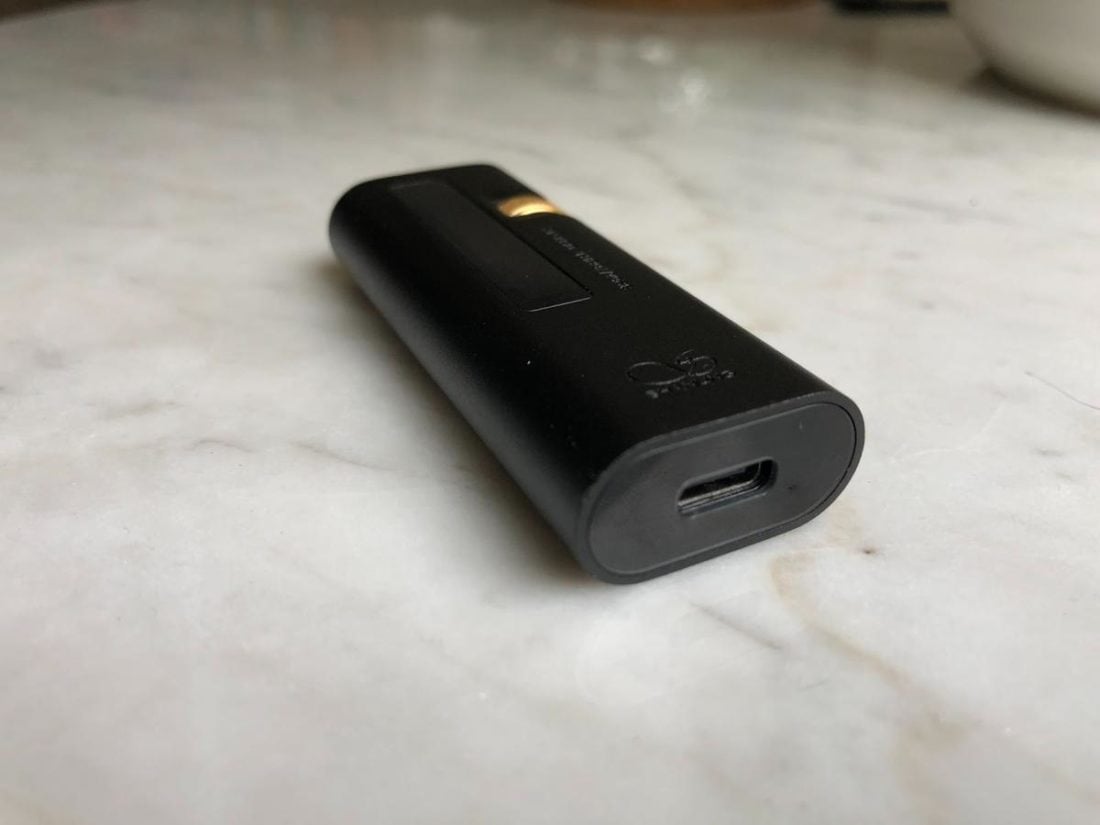
The all-aluminum construction (minus one plastic end cap) is smooth and seamless, and the UA5 feels more premium when compared to the S9Pro. It’s available in black or red, and various leather case options are offered.
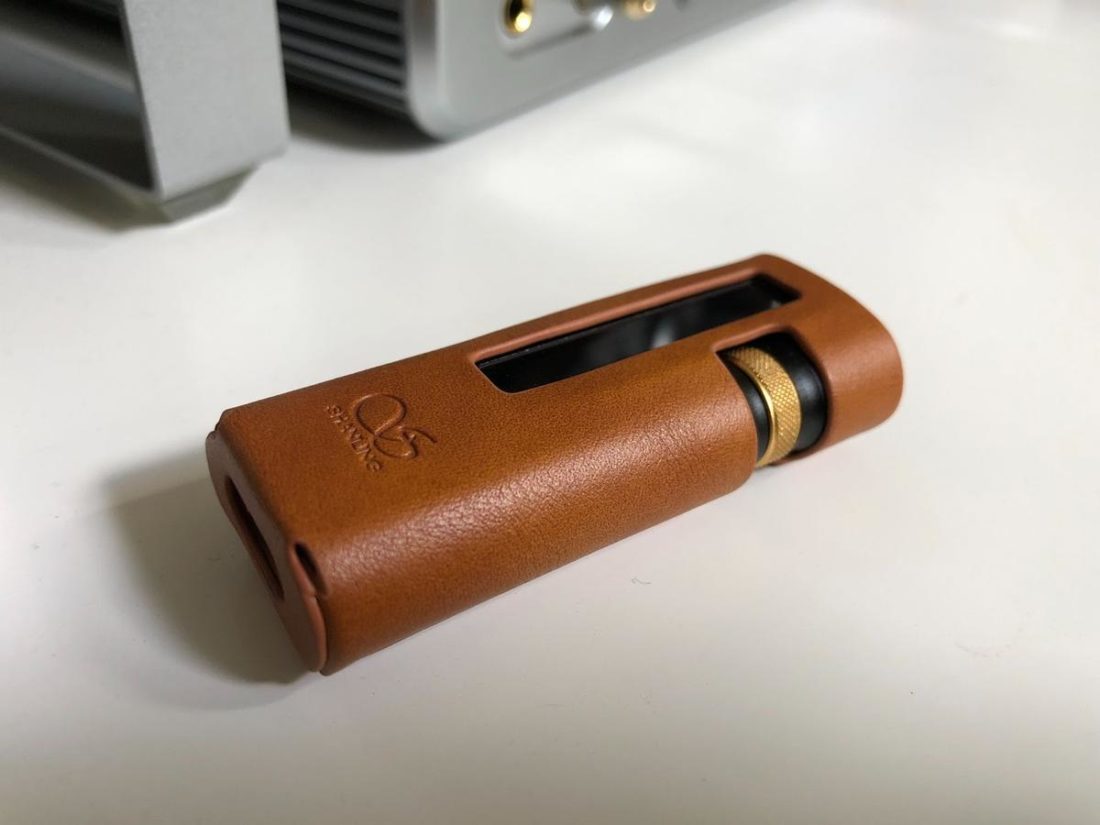
The front of the UA5 features a 1.4” monochrome OLED screen, while a handy, and frankly great feeling, volume/menu golden metal wheel/button is cut out of the side. The top end has the 3.5mm and 4.4mm pentaconn headphone outputs, while the USB-c socket is centered in the bottom end.
The small screen legibly serves up lots of helpful information, including volume level, sample rate, DAC mode, battery level, gain, etc. Additionally, paired with the single adjustment wheel, it serves as the method of selecting a surprising number of menu options.
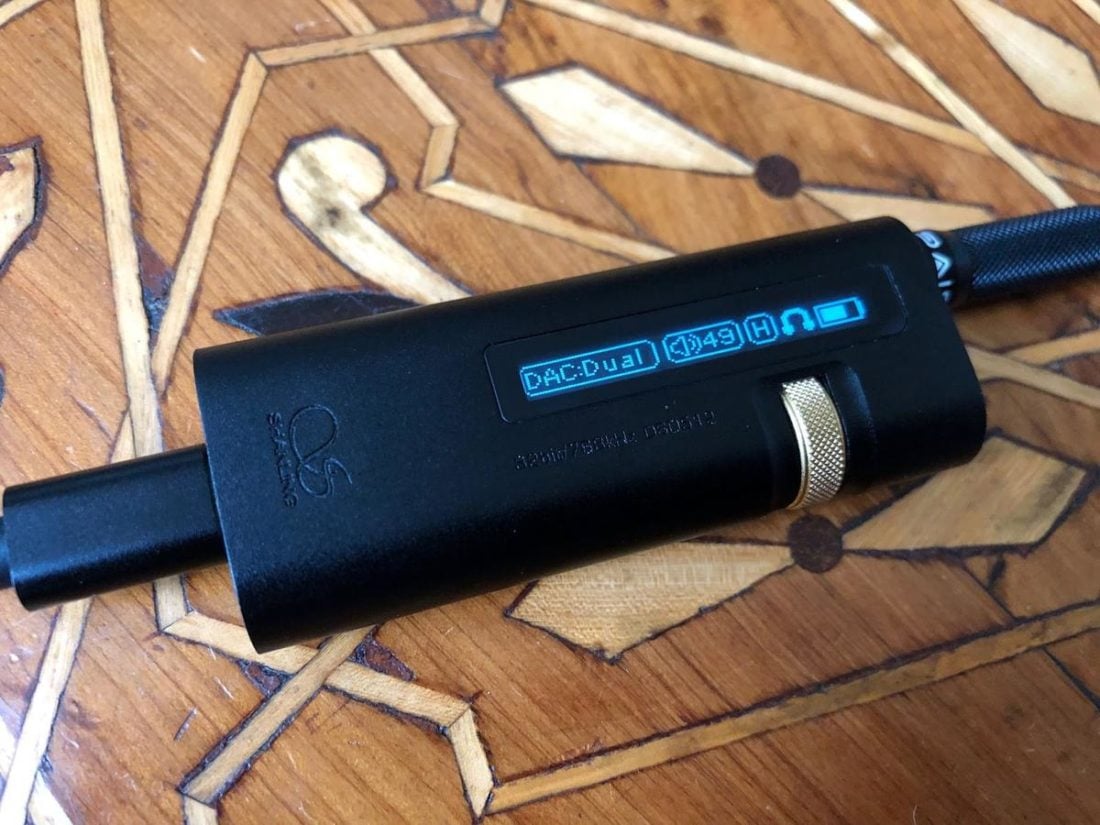
Menu structure
| Menu Item | Options | Description |
|---|---|---|
| DAC | Dual/Single | Enables one or two ESS DAC chips depending on the headphone output. |
| Charging | On/Off | Enables charging from the USB-c port. |
| Gain | High/Low | High gain has more volume output. |
| Power | USB power/Hybrid | Amp and DAC circuitry are powered from the internal battery (Hybrid) or all from the source device (USB power). |
| FIR | Hybrid, Apodizing, Mini Slow, Mini Fast, Linear Slow, Linear Fast, Brick Wall | These are the standard filters for current ESS DAC chipsets. In my experience, they make minimal sound changes. You can play around with them, but I tend to leave it at the default apodizing fast roll-off filter or brick wall filter. |
| Channel Balance | Left/Right | Balance adjustment. |
| SPDIF | On/Off | Enables/disables the 3.5mm socket to function as a coaxial SPDIF output. |
| Screen Off | 0-60 seconds | Change the time before the screen powers off in 5-second increments. |
| Brightness | Low-High | Changes the screen brightness. |
| Rotate | 0/180 | Flips the display. |
| Ver | 01.94.04 | Displays the current firmware version. |
Rotate the wheel to adjust the volume level. Long press to enter the menu. Rotate to adjust the menu option and quick press to select. Double press to lock or unlock the volume adjustment.

Internals
The digital signal from the USB port goes through a crystal oscillator, a CT7601 USB bridge chipset, and a custom FPGA (Field Programmable Gate Array). From there, the signal enters the dual ESS ES9038Q2M DAC chips (selectable single chip or dual mode) to be converted to analog and amplified via dual mono Ricore RT6863 op-amp chips.
Impressive for a tiny device? You bet!
The UA5 supports 32-bit/768 kHz PCM and DSD 512 but does not support MQA decoding.
SPDIF output
Including a coaxial SPDIF digital output is very unusual for a dongle-sized device. It may be a nod to the fairly limited power output of the UA5 and used if you’d like to pair its rather high-end DAC components to a more powerful standalone amplifier.
I can’t quite fathom a case where I’d use it, but, as they say, it’s better to have and not use than to want and not have.
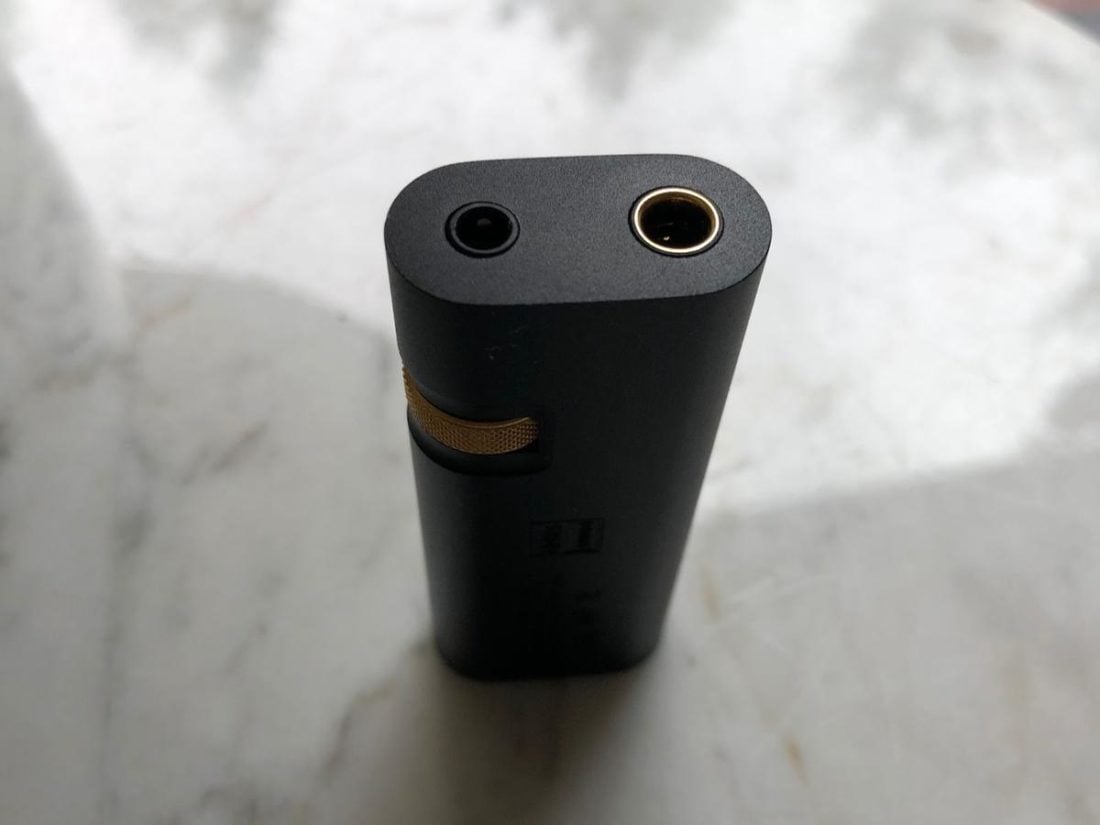
Battery
The user may choose to run the UA5 in USB power or in Hybrid mode. USB power mode means the source device powers the UA5, while Hybrid mode uses the internal 220 mAh battery to run the dual DAC and amp chips and circuitry, while the source device powers the USB and FPGA modules.
Battery life depends on the source file, volume level, and headphone output. It can range from 5 hours+ using the single-ended output to only about 2.5 hours using the balanced connection. A full charge takes about 30 minutes.
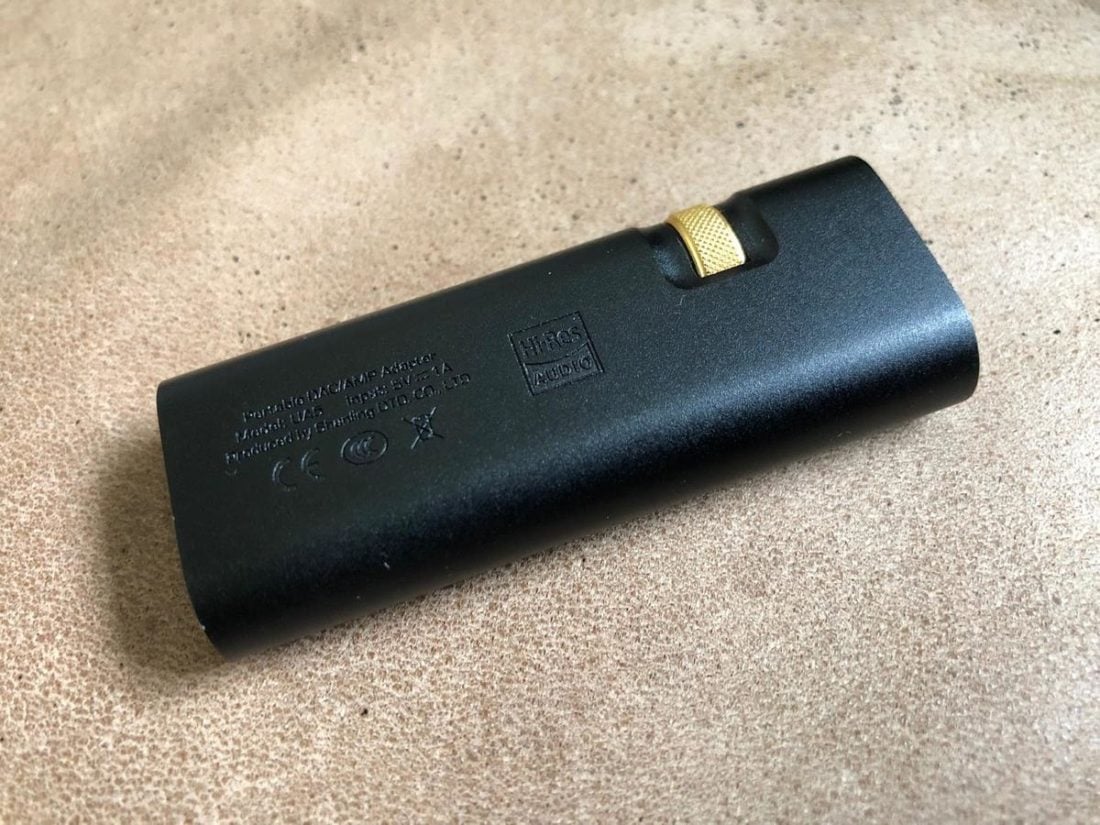
Power output
Beyond its small size, the main differentiator between the UA5 and a typical portable DAC/amp is the output power. Dongles that rely on the source device for power are typically more limited in output power than devices with internal batteries.
The relatively modest 137/211mW SE/bal @32Ohms power rating for the UA5 isn’t much more than the source-powered Hidizs S9Pro at 100/200mW SE/bal. This is, of course, more than enough for most efficient IEMs and headphones, and I found leaving the UA5 in High gain mode fine for all uses.
UA5 Sound
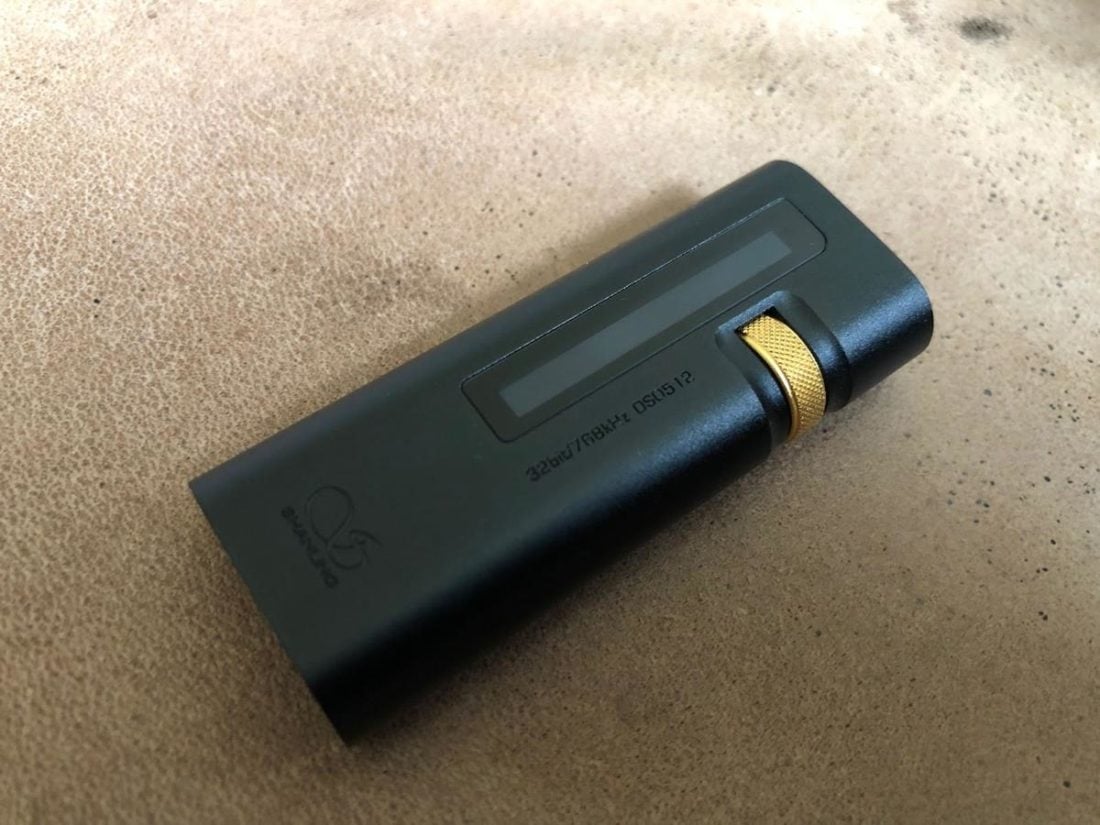
With most dongles, I tend to find less is more in terms of sound. I don’t want the device to have a distinct sonic character. I want it to have enough power to drive the transducers of choice cleanly, then to simply get out of the way and allow the sound of the headphones or IEMs to shine through.
If you are looking for a bold personality, you will likely be disappointed. However, the UA5 is up to the task if you want clear and uncolored sound on the go.
The UA5 has an essentially silent background, a must for tiny portable amplifiers that drive highly efficient IEMs. With the Thieaudio Monarch, I can not detect a noticeable noise floor at any reasonable listening level. The sound comes across as unaltered, and I feel I’m hearing the full potential of these excellent IEMs.
The UA5 is clearly up to the task for efficient loads. But what about with harder-to-drive headphones? I’m also currently testing the interesting new full-sized, dynamic driver cans from Sivga. The SV023 are 300 Ohm/105 dB, so while not especially inefficient, they provide a far higher impedance load.
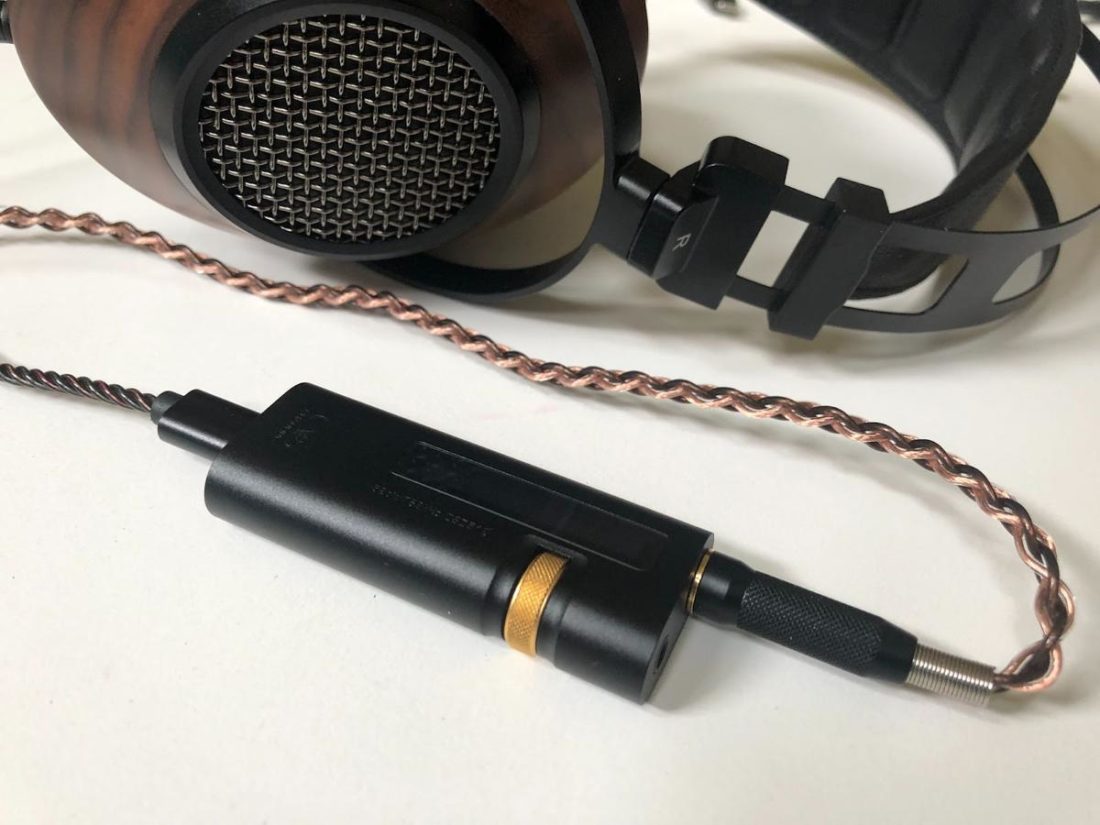
I enjoyed this pairing so much that they received most of my listening time with UA5.
Without spoiling anything from the upcoming review, the SV023 have a great warm and smooth sound signature that is sublimely easy to listen to. The uncolored nature of the UA5 proves to be a terrific matchup.
Power-wise, the UA5 has to be north of 50% on the internal volume control (with the source volume near maximum) to provide a medium-loud listening experience, but there are reserves still to go if desired.
Essentially the same can be said for the power-hungry HiFiMAN Ananda. The mighty little UA5 does a good job with these monster cans as well.
The unboosted nature of the UA5 translates to crisp and controlled bass, with good instrument separation and space. It’s a detailed sonic presentation free of blur or haze.
Where to Buy
Conclusion
The Shanling UA5 is neither clearly a dongle nor a portable DAC/amp. Rather it seems an evolution that provides many of the benefits of both categories – with few drawbacks. It’s small in size, yet feature-rich, boasting an impressive technical design and format support, as well as including an internal battery to reduce source load.
Sure, the UA5 commands a premium price for this sort of typically budget-oriented product. Still, the premium build and sound quality certainly go a long way towards justifying splurging for something better than merely average.
Dongles are – almost literally – a dime-a-dozen these days and are typically designed to appeal to budget-conscious consumers on the go. More serious audiophiles are often recommended to jump to a less portable, less convenient, but more fully-featured portable DAC/amp.
The UA5 makes a strong argument that perhaps, this time, one can actually have it all.
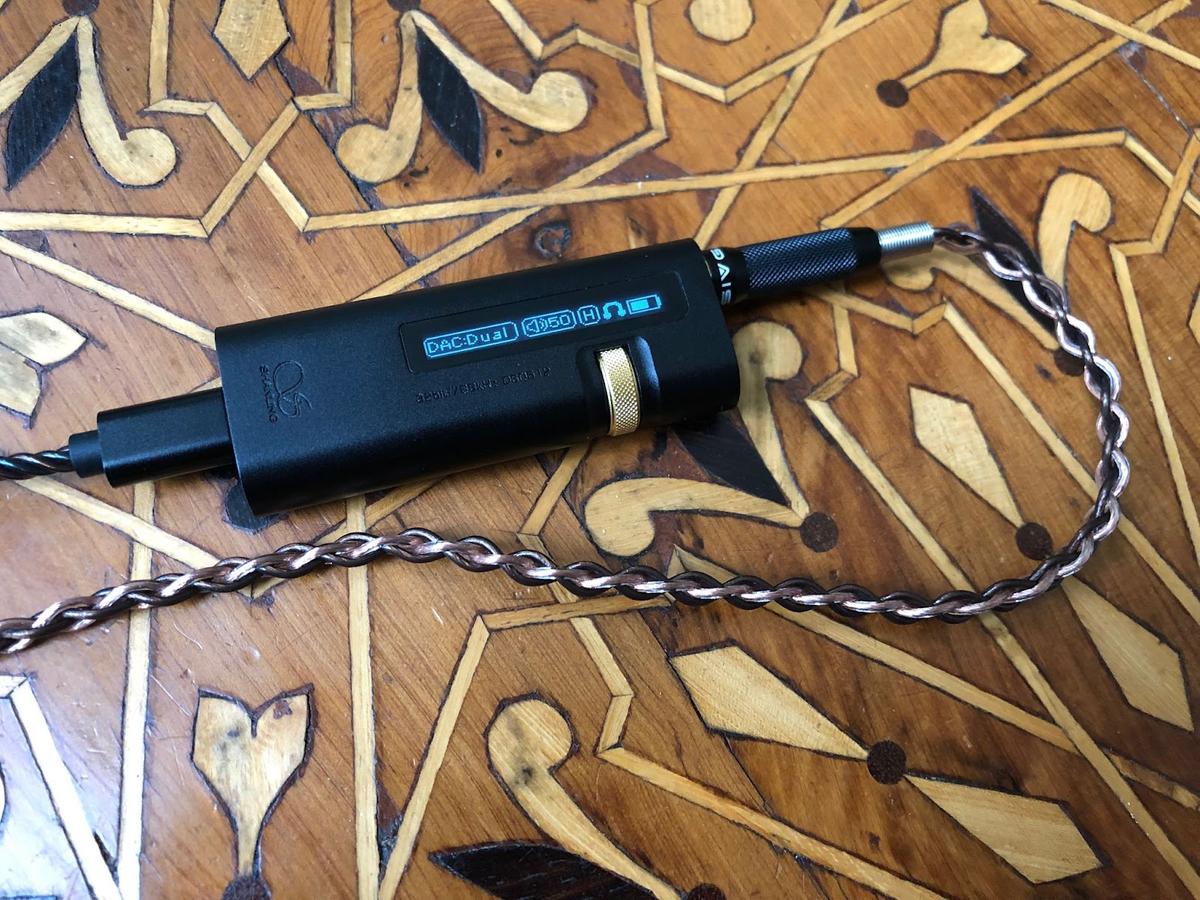
What about compare to Questyle M15?
I’m sorry, I haven’t had a chance to try the M5 yet.
Thanks for this review. What was the source streamer used when it was paired with the Sivga SV023 ? In hybrid power mode the source USB also contributes to the power. The battery is used only to power the DAC, is what I am given to understand and that may explain the ability to drive higher power wired headphones like the SV023
Hi. I primarily tested it with my iPhone X and the Hidizs AP80 DAP.
Thanks